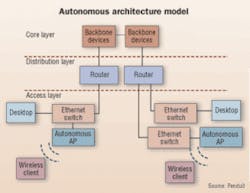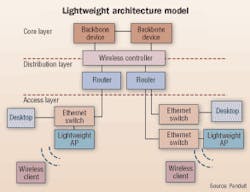Choosing the right WLAN architecture
Lightweight and autonomous systems each provide benefits and merit consideration.
Wireless local area networks (WLANs) are often implemented as an overlay to the wired LAN. The two distinct WLAN architectures in use are lightweight and autonomous, each having varied impact on the wired network infrastructure.
Selection of the right WLAN architecture can be difficult. Regardless of which architecture your choose, consideration should include building a futureproof, integrated wired and wireless network as vital to achieving a high return on investment.
While both architectures remain popular today, the trend is shifting to lightweight architectures taking over the WLAN market.
Two hierarchical models
In the face of this changing landscape, how do you choose your WLAN architecture? The two main architectures used in the WLAN environment differ in the extent that the wireless access point (WAP) has autonomy over access, security, and operation.
Lightweight WAPs, which form part of a centralized WLAN architecture, have limited functionality, with most of the wireless intelligence residing at a central controlling device (i.e., the WLAN controller).
By contrast, an autonomous architecture uses distributed WAPs that usually do not require a wireless controller.
To differentiate between a lightweight and an autonomous WLAN architecture requires an understanding of the role and hierarchy of devices in a network. For instance, in the network world, there is a widely accepted hierarchical model that identifies network devices by classifying them into one of three layers.
The model is straightforward; it identifies the devices that provide communications to the end user as the access layer, the devices providing internetwork communications as the distribution layer, and the core layer as the top layer responsible for transporting data quickly and reliable among networks. WAPs provide the first communications interface to the end user regardless of the architecture deployed, and reside at the edge of the network, or at the access layer.
In an autonomous architecture as depicted in the figure above, a wireless controller is not required. The autonomous WAPs support all necessary switching, security, and advanced networking functions necessary to route wireless traffic.
By contrast, in lightweight WLAN architectures (page 45), hardware consists of reduced-functionality WAPs that operate together with a centralized wireless controller. The controller resides deeper in the LAN, at the distribution or possibly the core layer. The WAPs do not function independently of the wireless controller.
Network management and layout
Traditionally, autonomous WAPs require individual management. Any configuration changes can be accomplished via a console port session, a telnet session, an http Web connection, or with an SNMP command. If a change must be made across the entire WLAN, every autonomous WAP must be reconfigured individually.
A lightweight architecture eases management of large deployments by permitting control of all WAPs from a single device. Because the lightweight WAPs also have visibility and awareness of the neighboring WAPs, they can supervise and alert the wireless controller if one of their neighbors becomes faulty. Lightweight WLANs can be self-healing because the controller commands neighboring WAPs to adjust their power levels to compensate for a failed counterpart.
In addition, the wireless controller can offload wireless clients to a neighboring WAP if a single WAP becomes overloaded. Load balancing and self-healing are important in mission-critical applications, such as wireless Voice over Internet Protocol (VoIP).
An autonomous WAP usually has no visibility of its WAP neighbors, and so cannot adjust its power levels to perform self-healing. It cannot load balance because it does not have control of its neighboring WAPs. In addition, it cannot distinguish whether a neighboring WAP is part of the WLAN infrastructure or an illicit rogue WAP.
The difference between the physical infrastructures of lightweight versus autonomous WLAN architectures (shown above) is minimal. The only additional component in a lightweight WLAN architecture is the WLAN controller. Both lightweight and autonomous WAPs need physical protection, such as that provided by a wireless access point enclosure, power from such power-sourcing equipment as Panduit’s DPoE Power Patch Panel, structured cabling, optional zone enclosures, and available switch ports from an Ethernet switch to provide connectivity with the wired LAN.
Choosing the architecture
Ultimately, the choice between an autonomous and a lightweight WLAN architecture will come after considering such important factors as network size, migration, and costs:
Network size. Autonomous WAPs can become difficult to manage if deployed in large numbers. There are no defined rules as to how large a deployment must be before it can be considered too large to manage. As a basic rule of thumb, if more than 5 to 10 WAPs are deployed, a lightweight solution can potentially be more cost-effective than an autonomous architecture. A lightweight architecture could translate into lower operational costs because network policies, security settings, and radio-frequency power settings can be managed from a single device. This architecture saves time versus managing individual WAPs, and it reduces human error.
As 'smart' as you want to be
The amount of intelligence desired is a factor when choosing a WLAN architecture. While basic coverage can be obtained with a few autonomous WAPs, advanced self-healing and optimization can be seamlessly performed with a lightweight architecture. Additionally, wireless VoIP, asset tracking, and other intelligent applications are best served by a lightweight WLAN solution because of the centralized management.
Densely packed WAPs can yield seamless wireless coverage, but often result in a large number of WAPs that are best managed with a lightweight WLAN solution. The number of WAPs deployed depends on the number of users, the amount of data traffic, and the desired data rate.
Migration. If a small wireless deployment requires only a few WAPs, the WLAN can be designed using autonomous WAPs. As wireless coverage is expanded with the addition of WAPs, the solution can be converted into a centralized lightweight architecture. Migration from an autonomous to a lightweight solution is possible with the addition of the wireless controller and an operating system upgrade to selected WAPs from certain equipment providers.
Costs. Generally, the hardware cost of a lightweight WAP tends to be lower than that of an autonomous WAP, but the cost of the wireless controller must be factored into the total cost. Furthermore, the lightweight solution often includes additional bundled security features, such as Virtual Private Networks and firewalls that otherwise would be purchased separately with an autonomous solution.
In addition to capital expenses, operational expenses are associated with each solution. These include time spent configuring network-wide policies, performing maintenance, troubleshooting, or making additions to the WLAN. In an autonomous solution, the cost of operational expenses increases significantly per WAP, whereas in the lightweight solution the operational expenses are minimally affected by network size. In a lightweight WLAN, it is possible to manage multiple WAPs with network-wide policies from a single controller.
A strict hardware price comparison between lightweight and autonomous WLAN architectures may not be possible, considering the feature sets of each will not be identical. Instead, the total cost of the WLAN must take into account both capital and operational expenses.
Architecture dictates choice
The type of architecture deployed in a WLAN is a major consideration. It is important to understand the differences between the two WLAN architectures, and the technical differences that affect management, operability, and the overall return on investment.
If futureproofing is a concern, you should choose a lightweight solution, since it can more readily ease management and improve security. If the size of your deployment is fairly small and the initial hardware cost is a concern, an autonomous solution may be suitable since the investment is protected with a migration path with certain equipment choices.BOB ELLIOT is product development manager and ELSA MADRIGAL is a research engineer at Panduit Corp. (www.panduit.com).



